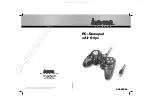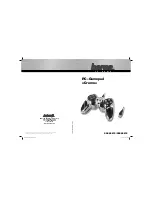
Types 1098-EGR and 1098H-EGR
19
4.
To replace the disk assembly (key 13), remove the
cotter pin (key 15). If not necessary, skip to step 7.
5. Install the disk assembly (key 13) and secure it
with the cotter pin (key 15).
6. Place backup ring (key 48) into the body
(key 1). Then place the body seal O-ring (key 11)
into the body.
7. Place the diaphragm casing (key 4) on the
body (key 1). Secure the the diaphragm casing to
the body with the cap screws (key 2) using 7 to
9 ft- lbs / 9.5 to 12 N•m.
Diaphragm and Spring Case Area
This procedure is for gaining access to the spring,
diaphragm, lever assembly stem and Type Y600AM
stem O-ring. All pressure must be released from the
diaphragm casing before performing these steps.
1. Remove the closing cap (key 22) and turn the
adjusting screw (key 35) counterclockwise to
remove the compression from the spring (key 6).
2. If the only maintenance is to change the control
spring, take out the control spring and replace
with the desired spring. Turn the adjusting screw
(key 35) clockwise to compress the spring to the
desired outlet pressure setting according to the
Installation and Startup section and restamp the
nameplate if necessary. Skip to step 11.
3. If further maintenance to the internal diaphragm
casing parts is required, remove the hex nuts (key 23,
not shown) and cap screws (key 24). Remove the
diaphragm (key 10) plus attached parts by tilting
them so that the pusher post (key 8) slips off the lever
assembly (key 16). To separate the diaphragm from
the attached parts, unscrew the cap screw (key 38)
from the pusher post (key 8). If the only maintenance
needed is to replace the diaphragm parts, skip to
step 7.
4.
To replace the lever assembly (key 16), remove
the machine screws (key 17). To replace the stem
(key 14) or stem O-ring (key 30), also perform
Body Area Maintenance procedure steps 1 and 4
and pull the stem (key 14) out of the diaphragm
casing (key 4). Grease the replacement stem
O-ring (key 30) with a good grade of lubricant and
install it on the stem (key 14).
5. Install the stem (key 14) into the diaphragm casing
(key 4) and perform Body Area Maintenance
procedure steps 6 through 8 as necessary.
6. Install the lever assembly (key 16) into the stem
(key 14) and secure the lever assembly with the
machine screws (key 17).
7. Hold the pusher post (key 8) and place diaphragm
assembly parts on the pusher post in the following
order: diaphragm (key 10), diaphragm head (key 7),
lower spring seat (key 50) and washer (key 36) and
secure with diaphragm cap screw (key 38) using 7 to
9 ft-lbs / 9.5 to 12 N•m of torque.
8. Install the pusher post (key 8) and attached parts
onto the lever (key 16).
9. Install the control spring (key 6) and spring case
(key 3) on the diaphragm casing (key 4) so that the
vent assembly (key 26) is correctly oriented and
secure them with the cap screws (key 24) and hex
nuts (key 23) to finger tightness only.
10. Turn the adjusting screw (key 35) clockwise until
there is enough control spring (key 6) force to provide
proper slack to the diaphragm (key 10). Using a
crisscross pattern, finish tightening the cap screws
(key 24) and hex nuts to 5 to 6 ft-lbs / 6.8 to 8.1 N•m
of torque. Finish turning the adjusting screw to the
desired outlet pressure setting.
11. Install the closing cap (key 22).
Type MR95H Supply Pressure Regulator
This section includes instructions for disassembly and
assembly of replacement parts. All key numbers refer
to Figure 22.
1. Unscrew the valve plug guide (key 5) from the
body (key 1). The valve plug spring (key 10) and
the valve plug (key 4) will normally come out of the
body along with the valve plug guide.
2.
Inspect the seating surface of the valve plug (key 4),
being sure that the composition surface (or polished
steel surface) of the valve plug is not damaged.
Replace if damaged.
3.
Inspect the seating edge of the orifice (key 3).
If damaged, unscrew the orifice from the body
and replace it with a new part. If no further
maintenance is required, reassemble the regulator
in the reverse of the above steps. When installing
the valve plug guide (key 5) coat the threads
and sealing surface with sealant to ensure an
adequate metal-to-metal seal.















































